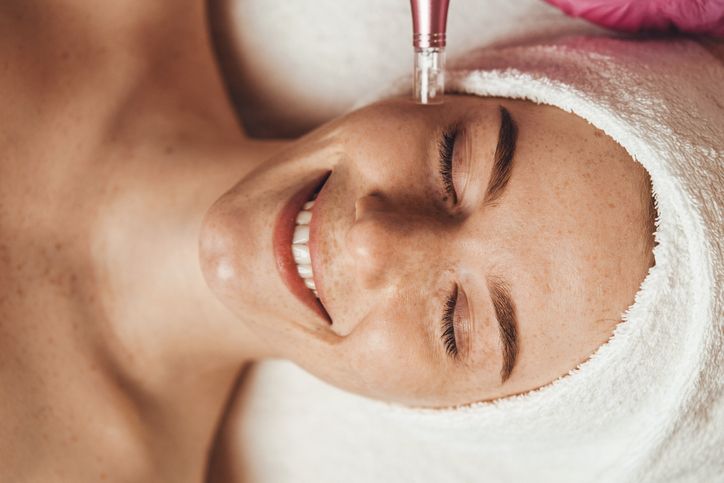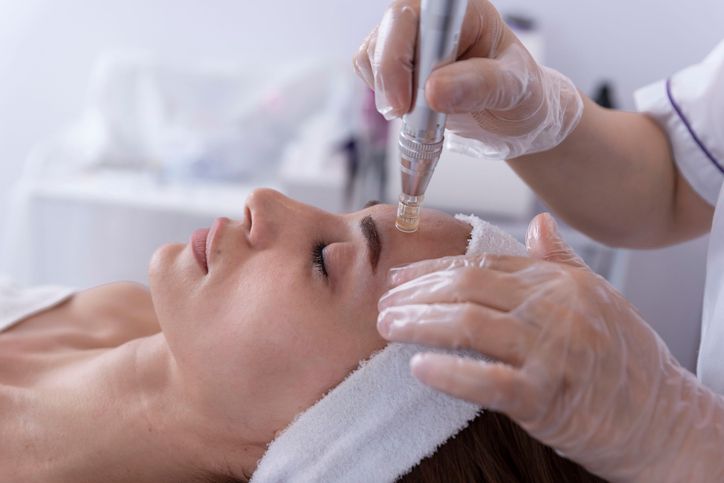- Home
- Trend
- Weight Loss Strategies
- Acne Tips
- Hair Health Information
- Blemish Removal Tips
- Acne Scar Removal Tips
- Muscle Building Techniques
- Intimate Care Tips
- Postpartum Intimate Care
- Eye Bags Wiki
- Tips for Face Slimming
- Secret of Permanent Hair Removal
- Breast Enlargement Tips
- Cure to Snoring
- Marionette Lines
- Skin-Tightening Secrets
Microneedling has become a popular aesthetic procedure among beauty lovers in recent years. The principle behind it is simple: by creating micro-injuries on the dermis layer of the skin, microneedling activates the body’s natural healing mechanism, resulting in skin renewal. Despite the thought of needles, there's no need to worry about deep or lasting wounds—microneedling is not powerful enough to cause serious damage or leave scars. While it's already been proven to be a safe cosmetic treatment, many people are still hesitant. Before trying it, learn about its five major beauty benefits and the most popular microneedling treatments available today—when used properly, it can safely transform your skin.
What Is Microneedling?

Microneedling is a modern medical aesthetic procedure that uses a roller covered in ultra-fine needles—often just 0.25mm in length. As the roller glides across the face, it creates thousands of microscopic channels in the skin. These tiny punctures are invisible to the naked eye but allow active skincare ingredients to penetrate deeply into the dermis. Once absorbed, they stimulate the production of fibroblasts and boost collagen synthesis, improving hydration and elasticity from within.
Even though these tiny needles slightly wound the dermis, the surface of the skin generally shows no visible signs of trauma, and any micro-injuries heal quickly. Once healed, noticeable skin rejuvenation results can be seen.
What Are the Main Ingredients Used in Microneedling?

Microneedling treatments on the market are typically paired with skin-rejuvenating active ingredients such as growth factors, glutathione, and various types of elastin-boosting nutrients. Growth factors help maintain the activity of fibroblasts, keratinocytes, epidermal cells, and nerve cells—crucial for skin metabolism and oxygenation. They are used to firm the skin, fight aging, reduce wrinkles, strengthen the skin barrier, and even heal post-surgical scars or pigmentation issues.
Home-use microneedling products like microneedle patches or masks often highlight their high hyaluronic acid or sodium hyaluronate content, promoting quick, visible hydration and collagen stimulation for plumper skin.
免費體驗
Acne Treatment
1 Minute Self-Registration
Date should not be before minimal date
Is Microneedling Suitable for Everyone?
The internet is full of dramatic before-and-after photos showing redness post-treatment, which scares many beauty enthusiasts away. But microneedling works by inducing repair—using controlled injury to activate the skin’s natural self-healing processes and stimulate the production of collagen and elastin. This is key to keeping the skin firm and youthful as it heals.
But is it truly suitable for all skin types? The topic remains controversial. In reality, if you have relatively normal, stable skin with no major breakouts or scars, microneedling may be unnecessary—regular skincare is usually sufficient.
Microneedling is especially beneficial for those with sensitive or acne-prone skin. These skin types often suffer from impaired healing and detoxification, so stimulating the skin through microneedling can enhance vitality and, after healing, lead to visible skin improvement.
Types of Microneedling: At-Home Tools vs. Professional Medical Treatments
Microneedling generally comes in three forms: rollers, patches, and matrix arrays.
• Microneedle Rollers (Derma Rollers): These are handheld rollers covered in tiny needles, rolled across the face to puncture the skin.
• Microneedle Patches: Similar to masks, these feature soluble micro-needles that dissolve upon contact with the skin.
• Matrix Arrays (Electronic Microneedling): These require devices like vibrators or injectors for application and are often known as "electric microneedling."
Each form exists in both home-use and medical-grade versions. While home devices are easy to buy online, incorrect technique—especially over-rolling or improper sterilization—can cause irritation or even worsen your skin condition. If you're not confident in your technique or aftercare, it’s best to seek professional treatment at a medical aesthetics clinic for safer results.
5 Common Types of Microneedling Tools
1. Solid Microneedles
The most common type. Needles puncture the skin, creating channels for skincare ingredients to be absorbed afterward.
2. Dissolvable Microneedles
Made of biodegradable materials that dissolve under the skin, delivering active ingredients directly into the tissue.
3. Hollow Microneedles
The principle behind the popular "water glow injections" (水光針), these use devices to apply pressure and inject nutrients through hollow needles.
4. Swelling Microneedles
Made from cross-linked hydrogels, which expand by absorbing intercellular fluid and release ingredients as they swell. These need to be manually removed afterward, as they aren’t dissolvable.
5. Coated Microneedles
Drugs or nutrients are coated on the surface of solid needles and delivered into the skin upon puncture.
Top 5 Skin Benefits of Microneedling
1. Fast Recovery
Microneedling helps skin repair itself more rapidly, ideal for healing post-surgery wounds or deep scars caused by burns or trauma. The needle-induced "threat" activates the immune system to accelerate healing.
2. Anti-Aging & Anti-Wrinkle
Helps tighten sagging skin and smooth out fine lines caused by UV damage and moisture loss. By delivering nutrients deep into the skin, microneedling promotes collagen production and reduces early signs of aging.
3. Minimizes Pores
Ideal for oily or acne-prone skin. By improving blood circulation and encouraging skin metabolism, microneedling helps purge clogged pores and normalize oil production, reducing the appearance of enlarged pores.
4. Scar & Spot Reduction
Microneedling breaks up melanin clusters, helping fade surface pigmentation such as sunspots or stretch marks. It also treats acne scars and more severe textural issues.
5. Evens Skin Tone
Microneedling can also improve red or purple acne marks, and blotchy, uneven areas caused by sensitivity. It promotes circulation to reduce inflammation and pigmentation.
免費體驗
Acne Treatment
1 Minute Self-Registration
Date should not be before minimal date
Comparing 6 Popular Medical Microneedling Treatments: Which Is the Most Effective?
1. Single-Needle Microneedling
Uses one thin needle to inject nutrients into targeted areas. Often used for spot treatments, hydration, wrinkle reduction, or localized fat dissolving.
2. Hydra Microneedling (Water Glow Injection)
Uses specialized devices and patented multi-needle injectors to deliver hydrating and anti-aging ingredients like growth factors, hyaluronic acid, collagen, peptides, and brightening agents. One of the most popular treatments.
3. Nano Microneedling
Uses nano-sized chips to create ultra-fine channels for deeper absorption—commonly used for whitening, acne treatment, and general skin rejuvenation. No anesthesia required, making it ideal for sensitive skin.
4. Linear Microneedling
Incorporates fine needles and absorbable PDO threads that stimulate collagen production. It’s effective in tightening the skin and treating wrinkles, especially crow’s feet and nasolabial folds.
5. Biological Microneedling
Usually in patch form, these are made with dissolvable materials that deliver nutrients upon light pressure. Used in anti-aging eye patches or brightening skin masks.
6. Radiofrequency Microneedling
Combines microneedling with radiofrequency technology to treat stubborn acne, stretch marks, and post-pregnancy skin issues. Provides deeper, more comprehensive rejuvenation.
Before & After Care Tips: Skipping These Could Wreck Your Skin!
Before Treatment:
• Avoid exfoliation and sun exposure 3 days prior.
• Stop using acids or retinoids, including oral isotretinoin.
• Postpone treatment if you have facial wounds or infections.
• Not recommended for those with:
- Keloids
- Diabetes
- Pregnancy
- Severe hypertension
- Chronic skin inflammation or folliculitis
After Treatment:
• Avoid exfoliating and sun exposure for 1 week.
• Prioritize moisturization and sun protection.
• Do not wash your face for at least 8 hours.
• Avoid spicy food, greasy meals, and alcohol to prevent irritation.
Want an Alternative to Microneedling? Try Perfect Medical’s Non-Invasive Acne Treatment!
Microneedling still sounds scary? Can't imagine needles touching your face? No worries—Perfect Medical’s Acne Separation Treatment offers a non-invasive, pain-free option to deeply cleanse and sterilize the skin. It effectively removes acne, blackheads, whiteheads, and textured skin without the trauma of needles.
The principle behind Perfect Medical’s Acne Treatment lies in its use of advanced dual-directional spiral suction drainage technology. This gently removes excess sebum and dead skin cells from the surface, while introducing a purifying formula to unclog pores that have been blocked by toxins. Once the skin achieves a balanced oil-water level, the treatment then stimulates the natural collagen regeneration process, enhancing the skin’s ability to heal and repair itself—leaving no room for acne and acne scars to take hold!
Perfect Medical’s Acne Treatment is completely non-invasive, meaning you won’t experience any psychological stress or pain during the session. There’s no obvious wound left behind afterward, either. Our professional team will also follow up on your skin condition to ensure optimal results, offering expert advice to help address acne at its root cause. Sign up now and enjoy: a professional skin analysis + Perfect Medical Acne Treatment, plus a free whitening and hydrating mask when you like our Facebook page! Limited spots available—come experience this tailor-made ultimate acne solution just for you!
Book Now: Acne Treatment免費體驗
Acne Treatment
1 Minute Self-Registration
Date should not be before minimal date
FAQ

How often should microneedling be done?
Typically, microneedling treatments should be performed every 1 to 2 months.
Should I use a microneedling roller at home or go to a medical aesthetic clinic?
Using a microneedling roller at home requires extremely skilled technique to achieve skin-rejuvenating results. Otherwise, it can easily backfire and damage your skin! It’s much safer to undergo microneedling at a licensed medical aesthetic clinic.
Does microneedling have side effects?
It varies from person to person, but common short-term reactions include redness, swelling, dermatitis, and in some cases, even swollen lymph nodes.
How do I use a microneedling roller at home?
It’s recommended to apply a topical anesthetic first, wait 20 minutes, and then roll on the targeted skin areas. However, it’s still best to leave this procedure to trained professionals.
Does microneedling hurt?
Most users online say they experience a slight tingling or pricking sensation, usually due to improper technique—but it’s not intensely painful.









